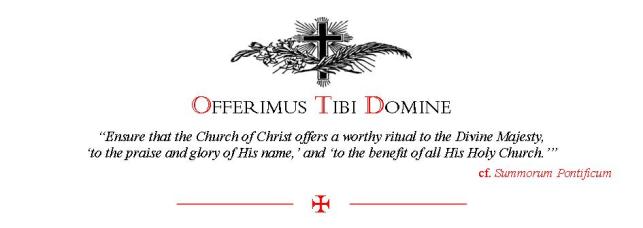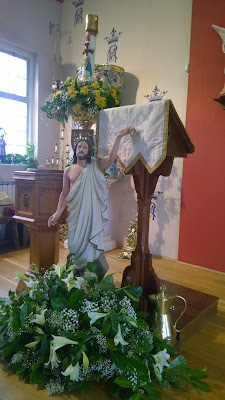The
Aleteia site carries a report that Cardinal Sarah has reminded priests that they are not obliged to wash the feet of women during Mass on Holy Thursday. They also report on Fr. Joseph Fessio's concerns that now the practice is
allowed, it will be
imposed by some bishops and superiors. There is also a quote from Bishop Athanasius Schneider, who feels that in conscience he could not do it. This is good to recall but what a pity that parts of the liturgy now have to be treated as "matters of conscience". We are used to hearing this from political parties who save face on issues on which they are divided by allowing a free vote "as a matter of conscience". The public liturgy of the Church should be - even when there are legitimate variations and differing rites - as unifying. But, of course, if a free interpretation of of what's actually written in the missal has become the usual experience of most Catholics, where insertions, additions and changes are randomly made at the whim (sorry, conscience) of every priest, extraordinary minister and reader we must expect that this attitude will become not just usual, but the "norm" in the technical liturgical sense. Perhaps we want to become a "broad church" where we are so broad that we don't share anything much at all.
Fortunately, the foot washing is optional, so it might be best to avoid controversy by not including it in the Mass. In my previous parish, we always celebrated it but nowadays, in a much smaller parish, I have never been able to find anything like 12 men to come forward for this act of service. We have Pope Pius XII to blame in this instance, perhaps it might have been better to leave it outside Mass, where presumably it would be a rarity occurring only in convents, monasteries and cathedrals.
This is the article:
Priests are not obligated to wash the feet of women during the Mass of the Lord’s Supper on Holy Thursday, Cardinal Robert Sarah has confirmed.
The prefect of the Congregation for Divine Worship and Discipline of the Sacraments told reporters in Rome on February 26 that every bishop or priest “has to decide in accord with his own conscience, and according to the purpose for which the Lord instituted this feast.”
Sarah’s clarification comes in response to an apparent disparity between the January 6 decree, In Missa in Cena Domini, and the accompanying explanatory note written by the Secretary for the Congregation for Divine Worship, Archbishop Arthur Roche.
The decree states that “pastors may [possint] select a small group of the faithful to represent the variety and the unity of each part of the people of God” and that “such small groups can [potest] be made up of men and women.”
And yet in the explanatory note, Archbishop Roche seems to suggest an obligation to choose a group representative of the entire people of God, without specifics as to sex. He writes: “It is for pastors to choose a small group of persons who are representative of the entire people of God — lay, ordained ministers, married, single, religious, healthy, sick, children, young people and the elderly — and not just one category or condition.”
Cardinal Sarah’s clarification comes after bishops and priests have voiced concerns about the new rubric, which permits the washing of women’s feet during the Mass of the Lord’s Supper. Before the foot-washing mandatum was changed by Pius XII and inserted into the Mass on Holy Thursday, women’s feet could be washed, but only by other women, and the ceremony took place outside of the Mass.
In a February 2, 2016, interview, Bishop Athanasius Schneider, auxiliary bishop of Astana, Kazakhstan, said that according to his conscience, he could not include women in the foot-washing ceremony on Holy Thursday. Bishop Schneider acknowledged that the revised mandatum isn’t binding, saying: “Thanks be to God no priest or bishop is obliged to wash publicly the feet of women on Holy Thursday, for there is no binding norm for it, and the foot washing itself is only facultative.”
Jesuit priest and founder of Ignatius Press, Fr. Joseph Fessio, SJ, has also weighed in, suggesting with skepticism that permissions are often misunderstood as requirements: “Of course it should be made clear that this is a permission, not a requirement,” he said. “But even that clarity won’t affect what actually happens.
“Here’s a similar situation in which we can already see the results: When permission was given for female altar servers, it was a permission given to bishops, not directly to priests (i.e., if a bishop so chose, he could permit the practice in the diocese). It was clear in the decree that no priest was required to have female servers, even if the bishop had given the permission. How was this treated? Many bishops insisted that the regular use of altar girls be normative for all Masses.
“So this new permission will be (and already has been) treated as a requirement.”
As to the substance, Fessio added: “The rite of washing of feet is not required, ever. As canon law now stands, duodecim viri (not duodecim homines) is specified.”
“Of course, as supreme legislator, the pope can (in theory) change the law any which way he desires,” Fr. Fessio acknowledged. “But the prototype is, of course, the Last Supper where Jesus washes the feet not of his disciples, not of people chosen randomly from the crowds but of the apostles, and tells them they should wash ‘one another’s’ feet. That is, ordained ministers should follow this example among themselves. Which is probably why, though the evidence for the rite in the early Church is very thin, we do know that in the 11th century the pope washed the feet of subdeacons. Certainly from the time of Trent (16th century) until 1955, the rite was not part of the Mass.
“One thing is certain,” Fr. Fessio said. “There is a ‘symbolic dissonance’ or disconnect. The humility and service of which Jesus gives an example is something every Christian owes everyone. Nevertheless, the historical origin of the example is Jesus’ washing of the feet of his 12 apostles. Trying to make the gesture more ‘inclusive’ than Jesus himself did simply muddles the historical image.”




































